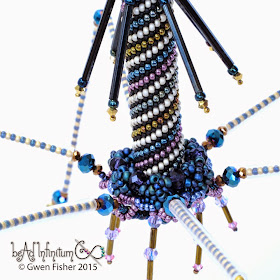Learn to bead a Book of Kells Bracelet with just Japanese seed beads,
shank buttons, and thread. No fancy shapes required! The Book of Kells weave is a fine beaded
fabric that is flexible and comfortable. You can weave it in many
different shapes because the pattern repeats like wallpaper.
This beading tutorial includes step-by-step instructions for weaving the aqua bracelet with the button hole clasp. This clasp is quite easy to do and undo, and it stays buttoned when you want it to. You will also learn how to layer the Book of Kells beadwork for 3D effects, and I show lots of examples to inspire you including these and more.
An unusual and complex angle weave, the Book of Kells design is suitable for intermediate bead weavers or advanced beginners who are comfortable with right angle weave. If you like RAW and want a new challenge, you’ll love this.
The beading tutorial is 29 pages, including over 100 illustrations and photographs. The tutorial is a PDF file that gives complete step-by-step instructions for how to make the aqua and black bracelet with a button clasp.
On pages 19-24 are step-by-step instructions for how to add layers to the Book of Kells lace to thicken it for pendants and bracelets. This includes step photos and brief instructions for the pendant shown. As an added bonus, for more advanced weavers, I also include clear photos of the front and back of the pink bracelet, with information on the clasp with brief hints and tips (pp. 25-26), a chunky dimensional bracelet with larger beads (p. 27), and even a few step photos and hints to get you started on the Book of Kells beaded bead (pp. 28-29).
The tutorial only gives a few key step photos and a bit of written guidance for the beaded bead because I think after you've made the pendant, the beaded bead won't looks so complicated. Plus, you advanced bead weavers need a little challenge from time to time to keep your minds nimble. Besides, after 29 pages of writing, I decided I needed to finish this tutorial and move onto the next project.
Here is what one customer said of this tutorial, "I am really enjoying this pattern. As always it is well written and illustrated, you have a way of presenting diagrams that make even the most complicated stitches understandable! It's turning out lovely."
If you're wondering why I called this design "Book of Kells" you should really pop on over to the Trinity College Dublin website and check out the 1200 year old Book. Give the page a second to load. It's setting up 680 thumbnails, photos of each page of the Book of Kells. Scroll about 1/8 the way down the list on the left, and click on folio 33R. That's the one that gave this design its name. While you're there, click on some of the other pages because the calligraphy is amazing. The carpet page of Folio 188r about 60% down is also worth taking the time to click on it.
Thanks for looking!
This beading tutorial includes step-by-step instructions for weaving the aqua bracelet with the button hole clasp. This clasp is quite easy to do and undo, and it stays buttoned when you want it to. You will also learn how to layer the Book of Kells beadwork for 3D effects, and I show lots of examples to inspire you including these and more.
An unusual and complex angle weave, the Book of Kells design is suitable for intermediate bead weavers or advanced beginners who are comfortable with right angle weave. If you like RAW and want a new challenge, you’ll love this.
The beading tutorial is 29 pages, including over 100 illustrations and photographs. The tutorial is a PDF file that gives complete step-by-step instructions for how to make the aqua and black bracelet with a button clasp.
On pages 19-24 are step-by-step instructions for how to add layers to the Book of Kells lace to thicken it for pendants and bracelets. This includes step photos and brief instructions for the pendant shown. As an added bonus, for more advanced weavers, I also include clear photos of the front and back of the pink bracelet, with information on the clasp with brief hints and tips (pp. 25-26), a chunky dimensional bracelet with larger beads (p. 27), and even a few step photos and hints to get you started on the Book of Kells beaded bead (pp. 28-29).
The tutorial only gives a few key step photos and a bit of written guidance for the beaded bead because I think after you've made the pendant, the beaded bead won't looks so complicated. Plus, you advanced bead weavers need a little challenge from time to time to keep your minds nimble. Besides, after 29 pages of writing, I decided I needed to finish this tutorial and move onto the next project.
Here is what one customer said of this tutorial, "I am really enjoying this pattern. As always it is well written and illustrated, you have a way of presenting diagrams that make even the most complicated stitches understandable! It's turning out lovely."
If you're wondering why I called this design "Book of Kells" you should really pop on over to the Trinity College Dublin website and check out the 1200 year old Book. Give the page a second to load. It's setting up 680 thumbnails, photos of each page of the Book of Kells. Scroll about 1/8 the way down the list on the left, and click on folio 33R. That's the one that gave this design its name. While you're there, click on some of the other pages because the calligraphy is amazing. The carpet page of Folio 188r about 60% down is also worth taking the time to click on it.
Thanks for looking!

















